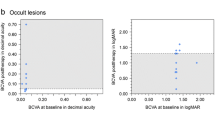Abstract
The purpose of this article is to describe functional and morphological short-term results in patients with exudative age-related macular degeneration (AMD) of all subtypes, treated with intravitreal bevacizumab versus intravitreal ranibizumab. This was a retrospective case-controlled series of 30 patients treated with intravitreal bevacizumab and 30 patients treated with intravitreal ranibizumab for exudative AMD. All patients received three initial injections every 4 weeks. Best corrected visual acuity (BCVA) as well as greatest linear dimension (GLD) of the CNV in fluorescein angiography and central retinal thickness (CRT) in optical coherence tomography (OCT) were monitored 2–4 months after last injection. BCVA stabilized and slightly increased from logMAR 0.74 to 0.62 in the bevacizumab group, and from logMAR 0.76 to 0.58 in the ranibizumab group (P < 0.05 for each group). No statistical difference was seen between both groups at any time-point. CRT was significantly reduced in both groups at last follow-up. In contrast, GLD did not change significantly. Patients with exudative AMD of all subtypes benefit from intravitreal anti-VEGF injections. No significant difference between bevacizumab and ranibizumab is seen in the short-term follow-up.



Similar content being viewed by others
References
Michaelson IC (1948) The mode of development of the vascular system of the retina with some observations on its significance for certain retinal diseases. Trans Ophthalmol Soc UK 68:137–180
Takahashi H, Shibuya M (2005) The vascular endothelial growth factor (VEGF)/VEGF receptor system and its role under physiological and pathological conditions. Clin Sci (Lond) 109:227–241
Aiello LP, Avery RL, Arrigg PG et al (1994) Vascular endothelial growth factor in ocular fluid of patients with diabetic retinopathy and other retinal disorders. N Engl J Med 331:1480–1487
Kvanta A, Algvere PV, Berglin L, Seregard S (1996) Subfoveal fibrovascular membranes in age-related macular degeneration express vascular endothelial growth factor. Invest Ophthalmol Vis Sci 37:1929–1934
Hera R, Keramidas M, Peoc′h M (2005) Expression of VEGF and angiopoietins in subfoveal membranes from patients with age-related macular degeneration. Am J Ophthalmol 139(4):589–596
Folkman J (1971) Tumor angiogenesis: therapeutic implications. N Engl J Med 285:1182–1186
Michels S, Rosenfeld PJ, Puliafito CA et al (2005) Systemic bevacizumab (Avastin) therapy for neovascular age-related macular degeneration; twelve-week results of an uncontrolled open-label study. Ophthalmology 112(6):1035–1047
Rosenfeld PJ, Moshfeghi AA, Puliafito CA (2005) Optical coherence tomography findings after an intravitreal injection of bevacizumab (Avastin) for neovascular age-related macular degeneration. Ophthalmic Surg Lasers Imaging 36(4):331–335
Kabbinavar F, Hurwitz HI, Fehrenbacher L et al (2003) Phase II, randomized trial comparing bevacizumab plus fluorouracil (FU)/leucovorin (LV) with FU/LV alone in patients with metastatic colorectal cancer. J Clin Oncol 21(1):60–65
Spaide RF, Laud K, Fine HF et al (2006) Intravitreal bevacizumab treatment of choroidal neovascularization secondary to age-related macular degeneration. Retina 26(4):383–390
Algvere PV, Steén B, Seregard S, Kvanta A (2008) A prospective study on intravitreal bevacizumab (Avastin) for neovascular age-related macular degeneration of different durations. Acta Ophthalmol 86(5):482–489
Bashshur ZF, Haddad ZA, Schakal A et al (2008) Intravitreal bevacizumab for treatment of neovascular age-related macular degeneration: a one-year prospective study. Am J Ophthalmol 145:249–256
Heier JS, Antoszyk AN, Pavan PR et al (2006) Ranibizumab for treatment of neovascular age-related macular degeneration: a phase I/II multicenter, controlled, multidose trial. Ophthalmology 113(4):642.e1–4
Kaiser PK, Blodi BA, Shapiro H, Acharya NR, MARINA Study Group (2007) Angiographic and optical coherence tomographic results of the MARINA study of ranibizumab in neovascular age-related macular degeneration. Ophthalmology 114(10):1868–1875
Kaiser PK, Brown DM, Zhang K et al (2007) Ranibizumab for predominantly classic neovascular age-related macular degeneration: subgroup analysis of first-year ANCHOR results. Am J Ophthalmol 114(6):850–857
Regillo CD, Brown DM, Abraham P et al (2008) Randomized, double-masked, sham-controlled trial of ranibizumab for neovascular age-related macular degeneration: PIER study year 1. Am J Ophthalmol 145(2):239–248
Raftery J, Clegg A, Jones J et al (2007) Ranibizumab (Lucentis) versus bevacizumab (Avastin): modelling cost effectiveness. Br J Ophthalmol 91:1244–1246
Jaissle GB, Szurman P, Bartz-Schmidt KU, German Retina Society, German Society of Ophthalmology, German Professional Association of Ophthalmologists (2005) Recommendation for the implementation of intravitreal injections—statement of the German Retina Society, the German Society of Ophthalmology (DOG) and the German Professional Association of Ophthalmologists (BVA). Klin Monatsbl Augenheilkd 222(5):390–395
Emerson MV, Lauer AK, Flaxel CJ et al (2007) Intravitreal bevacizumab (Avastin) treatment of neovascular age-related macular degeneration. Retina 27(4):439–444
Lazic R, Gabric N (2007) Intravitreally administered bevacizumab (Avastin) in minimally classic and occult choroidal neovascularization secondary to age-related macular degeneration. Graefes Arch Clin Exp Ophthalmol 245(1):68–73
Stewart MW (2007) Predicted biological activity of intravitreal bevacizumab. Retina 27(9):1196–1200
Zhu Q, Ziemssen F, Henke-Fahle S et al (2008) Vitreous levels of bevacizumab and vascular endothelial growth factor-A in patients with choroidal neovascularization. Ophthalmology 115(10):1750–1755
Keane PA, Liakopoulos S, Ongchin SC et al (2008) Quantitative subanalysis of optical coherence tomography after treatment with ranibizumab for neovascular age-related macular degeneration. Invest Ophthalmol Vis Sci 49(7):3115–3120
Author information
Authors and Affiliations
Corresponding author
Rights and permissions
About this article
Cite this article
Gamulescu, MA., Radeck, V., Lustinger, B. et al. Bevacizumab versus ranibizumab in the treatment of exudative age-related macular degeneration. Int Ophthalmol 30, 261–266 (2010). https://doi.org/10.1007/s10792-009-9318-7
Received:
Accepted:
Published:
Issue Date:
DOI: https://doi.org/10.1007/s10792-009-9318-7




